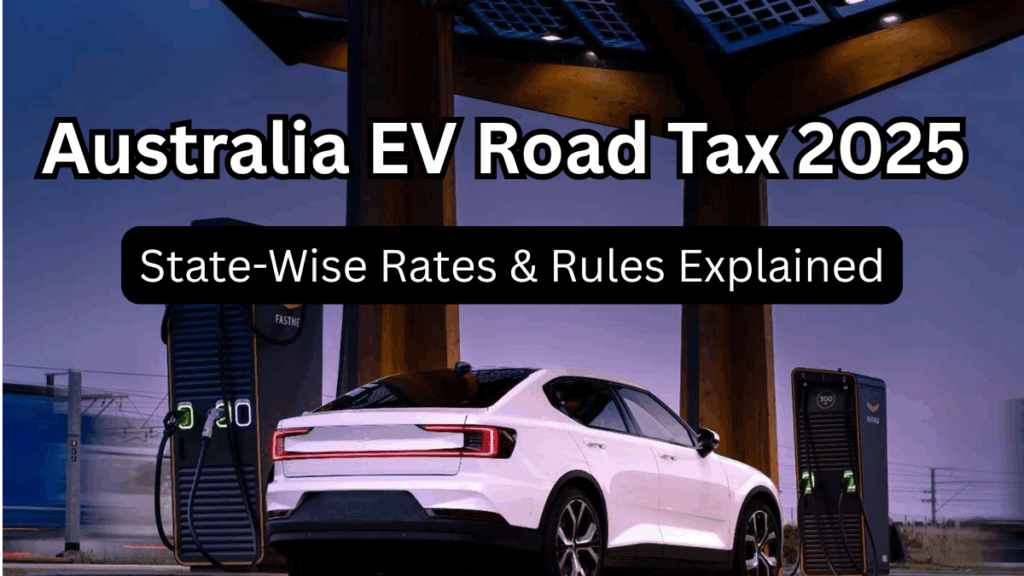With electric vehicles (EVs) rapidly gaining popularity in Australia, state governments have introduced new road tax structures to ensure fair contributions from all drivers. The Australia EV Road Tax Update 2025 brings clear guidelines on how these levies will work across different states, directly impacting EV owners.
Let’s explore the state-wise EV levy rules, rates, and important details you need to know for 2025.

Table of Contents
What is the Australia EV Road Tax Update 2025?
The Australia EV Road Tax Update 2025 introduces a distance-based levy specifically for electric and low-emission vehicles. Since EV drivers don’t pay traditional fuel excise taxes, this update aims to create a fairer road funding system.
Key Highlights:
-
A per-kilometre charge for EV drivers.
-
Different rates across Australian states.
-
Applies to battery electric vehicles (BEVs), hydrogen fuel cell vehicles (FCEVs), and in some cases, plug-in hybrids (PHEVs).
Why Was the EV Road Tax Introduced?
Since EVs avoid fuel excise, governments are looking for sustainable road funding alternatives. This tax helps balance contributions between EV and petrol vehicle owners.
Objectives:
-
Maintain road infrastructure funding.
-
Ensure all road users contribute fairly.
-
Support the growth of EV infrastructure while protecting public budgets.
Australia EV Road Tax Update 2025: State-Wise EV Levy Rules
Here’s a state-wise breakdown of EV road tax rates and policies as per the Australia EV Road Tax Update 2025:
State / Territory |
Road Tax Rate (Per Km) |
Applies To |
Additional Notes |
|---|---|---|---|
Victoria |
2.8 cents |
EVs, FCEVs, PHEVs |
Annual odometer readings required |
New South Wales |
2.8 cents |
EVs, FCEVs |
Starts from 2027, unless earlier EV target is met |
South Australia |
Policy on Hold |
– |
Initially planned, now delayed |
Western Australia |
No EV-specific tax yet |
– |
Monitoring other states |
Queensland |
Under review |
– |
Expected announcement in late 2025 |
Tasmania |
No EV-specific tax yet |
– |
Focused on EV adoption incentives |
ACT |
No EV-specific tax yet |
– |
Offers road tax exemptions for EVs |
Northern Territory |
No EV-specific tax yet |
– |
Currently encouraging EV uptake |
Key Points for EV Owners
-
Victoria is leading the rollout: It is currently the only state actively charging EV road tax.
-
New South Wales is next: Road usage charges will start in 2027.
-
South Australia paused the plan: Originally proposed but now on hold.
-
Other states are monitoring: Some are prioritising EV growth rather than introducing taxes immediately.
How Will the Road Usage Charge Work?
-
EV owners must submit odometer readings each year.
-
The total tax is based on annual kilometres driven.
-
Payments can be made yearly or in instalments, depending on the state’s system.
Potential Benefits and Concerns
Benefits:
-
Provides long-term road funding.
-
Ensures fairness across all vehicle types.
Concerns:
-
Might discourage some drivers from switching to EVs.
-
Complex for drivers who frequently cross state borders.
Future of EV Road Tax in Australia
The Australia EV Road Tax Update 2025 is just the beginning. A more unified, possibly national, EV road funding policy may emerge in the coming years as EV adoption accelerates and governments aim for consistency.
FAQs
1. What is the Australia EV Road Tax Update 2025?
The update introduces per-kilometre road usage charges for electric vehicles to ensure fair contributions to road maintenance since EVs don’t pay fuel taxes.
2. Which states have implemented EV road taxes in 2025?
Victoria currently enforces the road tax, New South Wales will follow in 2027, while other states like South Australia have put plans on hold.
3. How is the tax calculated under state-wise EV levy rules?
The tax is based on annual kilometres driven, recorded through yearly odometer checks, with rates set by individual states.
4. Will the EV road tax reduce EV adoption?
Some believe the tax might slow EV sales, but the ongoing incentives and environmental benefits still make EVs a strong choice for many drivers.
Click here to learn more
